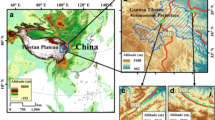Abstract
Increased urban development, including an increase in impervious surfaces has the potential to alter the biogeochemistry of surface systems due to storm water runoff contaminated with potentially toxic trace metals (e.g. Zn, Cu and Pb). A major source for urban metals is dust that accumulates on roadways. This roadway dust is derived from vehicle wear sources and tends to be enriched in trace metals such as Pb, Zn, Cu, Cd, Ni and Cr. This continuous source is then being transported via storm water runoff to receiving systems, such as storm water retention systems, which become important focusing environments for trace metal deposition. The fate of these roadway derived metals and their bioavailability once deposited in these urban ecosystems is not well understood. In this investigation we tested the hypothesis that the distribution and form of surface deposited roadway-derived Zn is a function of earthworm processes and is species dependent. The results of this investigation indicate that roadway dust derived Zn deposited as a surface layer on urban soils is readily removed from the surface in less than 30 days whether earthworms are present or not. However, after 90 days, the presence of earthworms and the life habit of the earthworm species present was found to have a significant impact on the physical and chemical cycling of roadway derived trace metals in storm water retention basin soils.


Similar content being viewed by others
References
Bouche MB (1977) Strategies lombriciennes. In: Lohm U, Persson T (eds) Soil organisms as components of ecosystems, vol 25. Ecological Bulletin, Stockholm, pp 122–132
Camponelli KM, Snodgrass JW, Lev SM, Landa ER, Casey RE (2010) Chemical fractionation of Cu and Zn in stormwater, roadway dust and stormwater pond. Environ Pollut 158:2143–2149
Councell TB, Duckenfield KU, Landa ER, Callender E (2004) Tire wear particles as a source of zinc to the environment. Environ Sci Technol 38:4206–4214
Davis AP, Shokouhian M, Ni S (2001) Loading estimates of lead, copper, cadmium, and zinc in urban runoff from specific sources. Chemosphere 44:997–1009
Davis AP, Shokouhian M, Sharma M, Minami C, Winogradoff D (2003) Water quality improvement through bioretention: lead, copper and zinc removal. Water Environ Res 57(1):73–75
Divrikli U, Soylak M, Elci L, Dogan M (2003) The investigation of trace heavy metal concentrations in the street dust samples collected from Kayseri, Turkey. Soil Environ Sci 21:713–720
Gish CD, Christensen RE (1973) Cadmium, nickel, lead, and zinc in earthworms from roadside soil. Environ Sci Technol 7(11):1060–1062
Kayhanian M, Singh A, Suverkropp C, Borroum S (2003) Impact of annual average daily traffic on highway runoff pollutant concentrations. J Environ Eng 129:975–990
Kizilkaya R (2004) Cu and Zn accumulation in earthworm Lumbricus terrestris L. in sewage sludge amended soil and fractions of Cu and Zn in casts and surrounding soil. Ecol Eng 22:141–151
Lanno R, Wells J, Conder K, Bradham K, Basta N (2004) The bioavailability of chemicals in soil for earthworms. Ecotoxicol Environ Saf 57:39–47
Lev SM, Matthies N, Snodgrass J, Casey R, Ownby D (2010) Isolating the effect of Zinc exposure on Lumbricus terrestris in an artificial soil. Bull Environ Contam Toxicol 158:2143–2149
Manno E, Varrica D, Dongarrá G (2006) Metal distribution in road dust samples collected in an urban area close to a petrochemical plant at Gela, Sicily. Atmos Environ 40:5929–5941
Morgan JE, Morgan AJ (1990) The distribution of cadmium, copper. Lead, zinc and calcium in the tissues of the earthworm Lumbricus rubellus sampled from one uncontaminated and four polluted soils. Oecologia 84:559–566
Morgan JE, Morgan AJ (1999) The accumulation of metals (Cd, Cu, Pb, Zn and Ca) by two ecologically contrasting species (Lumbricus rubellus and Aporrectodea caliginosa): implications for ecotoxicological testing. Appl Soil Ecol 13:9–20
Pižl V, Josens G (1995) The influence of traffic pollution on earthworms and their heavy metal contents in an urban ecosystem. Pedobiologia 39:442–453
Sizmur T, Hodson ME (2009) Do earthworms impact metal mobilitiy in soil?—A review. Environ Pollut 157:1981–1989
Sun X, Davis AP (2007) Heavy metal fates in laboratory bioretention systems. Chemosphere 66(9):1601–1609
Tessier A, Campbell PGC, Bisson M (1979) Sequential extraction procedure for the speciation of particulate trace metals. Anal Chem 51(7):844–851
Tomlin AD, Shipitalo MJ, Edwards WM, Protz R (1995) Earthworms and their influence on soil structure and infiltration. In: Hendrix PF (ed) Ecology and biogeography of earthworms in North America. Lewis Publishers, Boca Raton, pp 159–185
Tüzen M (2003) Investigation of heavy metal levels in street dust samples in Tokat, Turkey. Soil Environ Sci 21(3):513–521
Vijver MG, Vink JPM, Jager T, Wolterbeek HT, van Straalen NM, van Gestel CAM (2005) Biphasic elimination and uptake kinetics of Zn and Cd in the earthworm Lumbricus rubellus exposed to contaminated flood plain soil. Soil Biol Biochem 37:1843–1851
Wang WH, Wong MH, Leharne S, Fisher B (1998) Fractionation and biotoxicity of heavy metals in urban dusts collected from Hong Kong and London. Environ Geochem Health 20:185–198
Zorn MI, Cornelis AM, Gestel V, Eijsakers H (2005a) The effect of two endogenic earthworm species on zinc distribution and availability in artificial soil columns. Soil Biol Biochem 37:917–925
Zorn MI, Cornelis AM, Gestel V, Eijsakers H (2005b) The effect of Lumbricus rebellus and Lumbricus terrestris zinc distribution and availability in artificial soil columns. Biol Fertil Soils 41:212–215
Acknowledgments
The authors would like to thank the Smithsonian Environmental Research Center and Dr. Allen Davis from the University of Maryland, College Park for their support with this project and access to the field sites. Towson University and the US Geological Survey supplied funding to support this project.
Author information
Authors and Affiliations
Corresponding author
Rights and permissions
About this article
Cite this article
Carroll, W., Snodgrass, J.W., Szlavecz, K. et al. The effect of earthworms on roadway-derived Zn deposited as a surface layer in storm water retention basin soils. Urban Ecosyst 17, 825–838 (2014). https://doi.org/10.1007/s11252-014-0355-2
Published:
Issue Date:
DOI: https://doi.org/10.1007/s11252-014-0355-2




